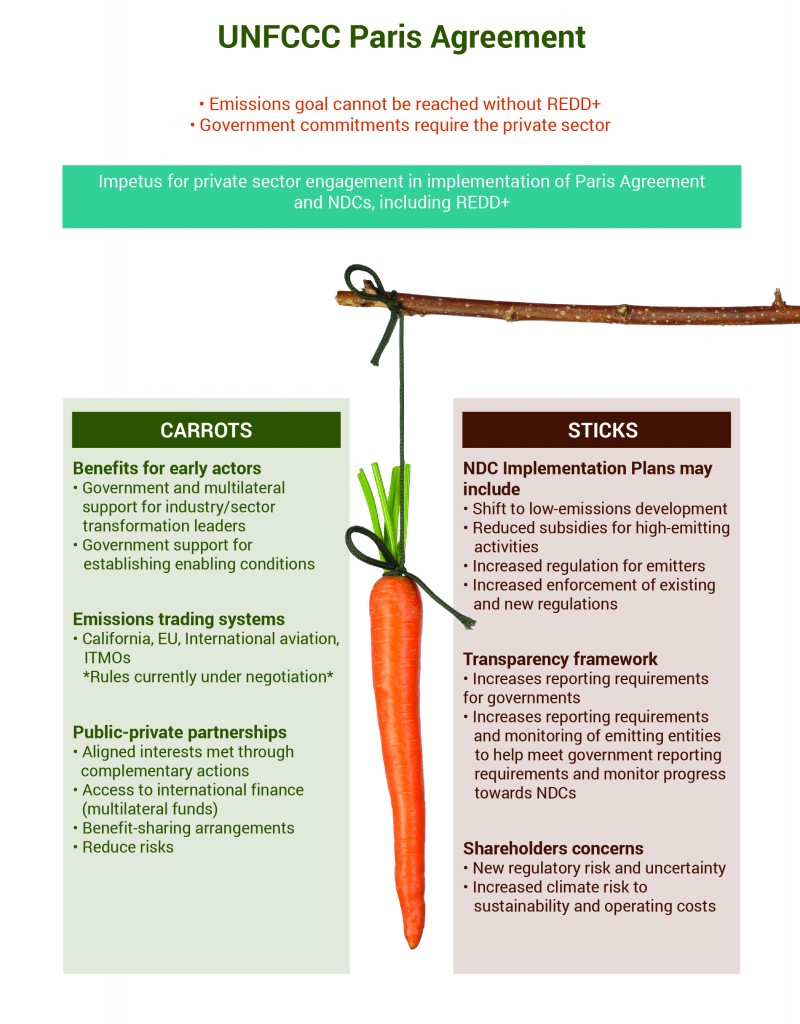What’s the biggest missing link in finding the money needed to protect forests?
It’s not political will or public finance – though more is certainly needed – nor is it formal UN recognition of their importance; forests achieved that last December in Paris. What’s missing is the untapped power of the private sector.
One of the big surprises that came out of the Paris Agreement was the explicit recognition of the key role that forests (and land use, including agriculture) could play in reducing global warming pollution. The most promising opportunity to use forests for climate action is through a UN program known as Reducing Emissions from Deforestation and forest Degradation, or REDD+. And as Forest Trends research shows, over the last 10 years most of the money – approximately 90% – in 13 key REDD+ countries has come from public sources.
To be sure, the private sector has made some important investments to help get REDD+ off the ground. Unilever and other consumer goods companies made strong pledges in Paris to eliminate deforestation from their supply chains. But for many reasons, including policy uncertainty and the relatively small number of countries that have working national- and state-level REDD+ programs, there haven’t been enough places to channel sustainable, long-term investments.
The good news is that this problem can be fixed. In a new report, “The Implications of the Paris Climate Agreement for Private Sector Roles in REDD+,” which I co-authored with former Canadian REDD+ negotiator Peter Graham, Forest Trends recommends that governments use both “carrots” and “sticks” – incentives and obligations – as a way to create the right policies and incentives to spur the private sector to act, either voluntarily or to comply with domestic law, on behalf of forests.
On the other side of the equation, we conclude that business leadership should better align corporate and government policies to achieve the goals of the Paris Agreement.
We base our recommendations on three important “lessons” gleaned from decades of implementing international climate change agreements:
- Limits on public finance will always exist, including with regards to amounts and purpose.
- Governments need the active engagement of the private sector in order to meet and raise ambitious mitigation targets and provide private finance flows far greater than those from public sources.
- Achieving national goals for the forest and land sector often requires implementation of policy and programs at the local level, where the private sector can play a crucial role in spurring change.
Recognizing those lessons, we offer three recommendations to bring governments and the private sector together to achieve the goals of the Paris Agreement:
- Urge governments and the private sector to actively collaborate in assessing the implications of the Paris Agreement when developing and implementing countries’ nationally determined contributions (NDCs). The next few months and years will be important as countries collectively agree on the rules for carbon markets and on how REDD+ fits into national climate plans. The experience that the private sector brings to the table is critical – from both voluntary approaches, such as the commitments to eliminate deforestation from their supply chains, as well as experience with climate regulation and carbon markets – and can play an important role in helping governments create the best policies.
- Use private sector experience with, and interest in, carbon markets to inform government positions and proposals in upcoming UN negotiations. The UN has asked for views from countries and key stakeholders, including NGOs and the private sector. The first deadline for this type of input, known as a “Call for Submissions” in UN-speak, is September 30, and a key focus for this round is the article that deals with carbon markets. Article 6 of the agreement does not establish or explicitly recognize carbon markets nor does it offer detailed guidance on how they should be structured or governed– except for the condition that double-counting of emissions reductions must be avoided. Rather, it establishes a broad framework that creates “collaborative approaches,” which allow for the use of carbon markets.
- Develop public-private partnerships that create and improve the enabling conditions necessary to attract private sector capital. In order to achieve REDD+ objectives to halt deforestation and restore forest ecosystems, we need to see greater alignment and mobilization of private sector finance to support developing countries’ REDD+ ambitions. While public funds have contributed to significant progress in several countries over the last 10 years, achieving and maintaining results will require tapping into the financial resources of the private sector. For its part, the private sector needs the right conditions to be able to assess and manage risk and receive an adequate return on investments.
As my co-author Peter put it, “As governments around the world set in motion the policies and activities needed to meet their climate change targets under the Paris Agreement, more and more businesses, from farmers to investment firms, will need to pay attention to the associated risks and opportunities. Reducing deforestation and improving forest management are perfect examples of where there is immediate opportunity for governments and companies to collaborate to reduce a major source of emissions while also reducing risks to sustainable business.”
For more information, read the full report and visit www.reddx.forest-trends.org.
Viewpoints showcases expert analysis and commentary from the Forest Trends team.
Connect with us on Facebook and Twitter to follow our latest work.

